Analysis of Human Resource Management: HND Unit 21 Business Report
VerifiedAdded on 2021/08/10
|9
|3712
|82
Report
AI Summary
This report provides a comprehensive overview of Human Resource Management (HRM), contrasting it with personnel management and highlighting its strategic importance in modern organizations. The report discusses the evolution of HRM, emphasizing its role in aligning organizational goals with employee well-being, training, and development. It examines the implications of HRM strategies across different departments and the impact of factors like globalization and workforce diversification. The report delves into the author's experience as a line manager at Tesco PLC, detailing practical applications of HRM principles, including performance management, employee engagement, and adherence to legal frameworks such as Title VII of the Civil Rights Act of 1964 and the Occupational Safety and Health Act of 1970. Furthermore, the report explores HR planning, including the five stages involved (assessing human resources, demand forecasting, supply forecasting, matching demand and supply, and action plan), and recruitment and selection processes. The report concludes with an analysis of employee motivation, including financial rewards, Maslow's hierarchy of needs, and various motivational strategies. The report uses real-world examples from the author's experience at Tesco to illustrate key HRM concepts.
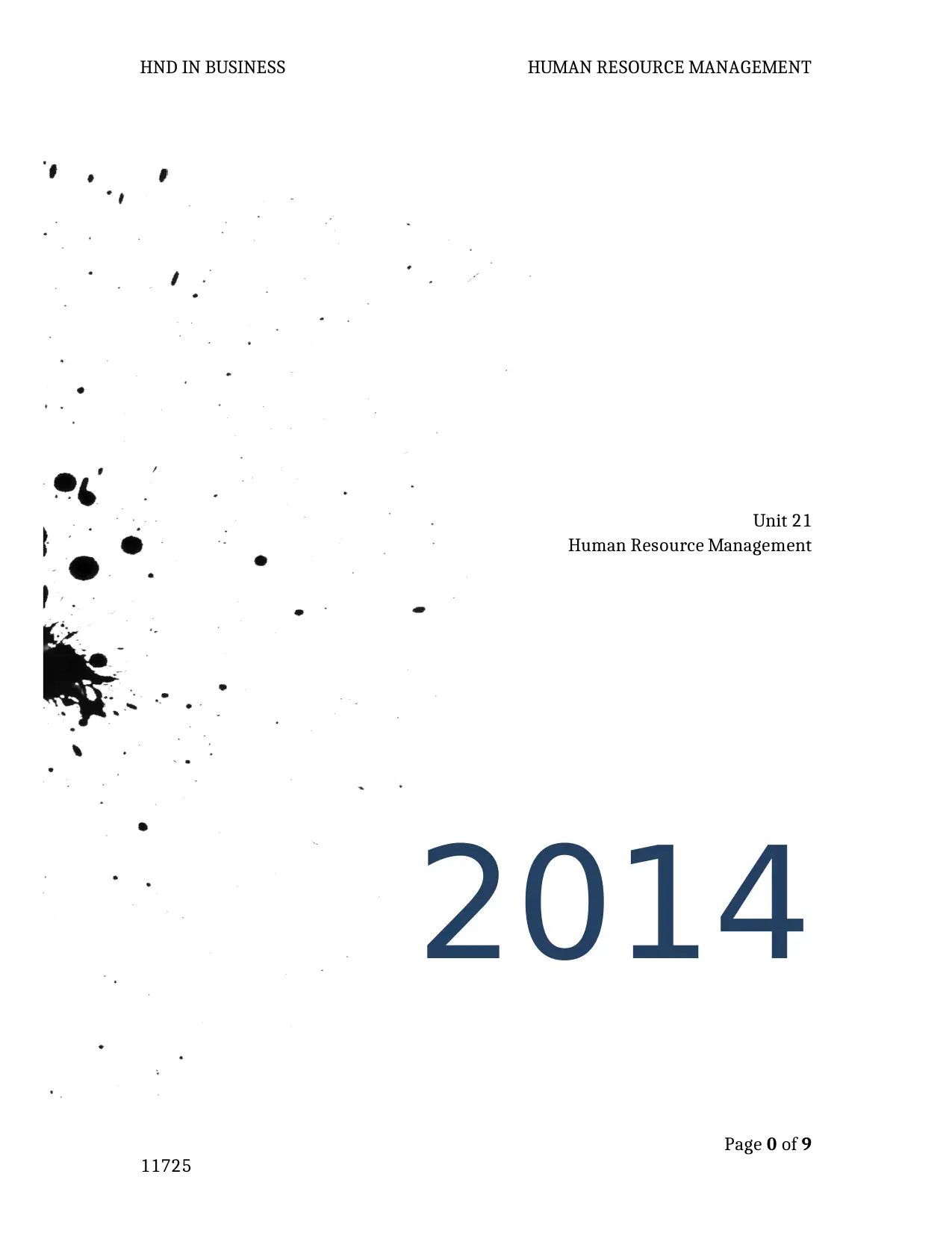
HND IN BUSINESS HUMAN RESOURCE MANAGEMENT
Unit 21
Human Resource Management
2014
Page 0 of 9
11725
Unit 21
Human Resource Management
2014
Page 0 of 9
11725
Paraphrase This Document
Need a fresh take? Get an instant paraphrase of this document with our AI Paraphraser
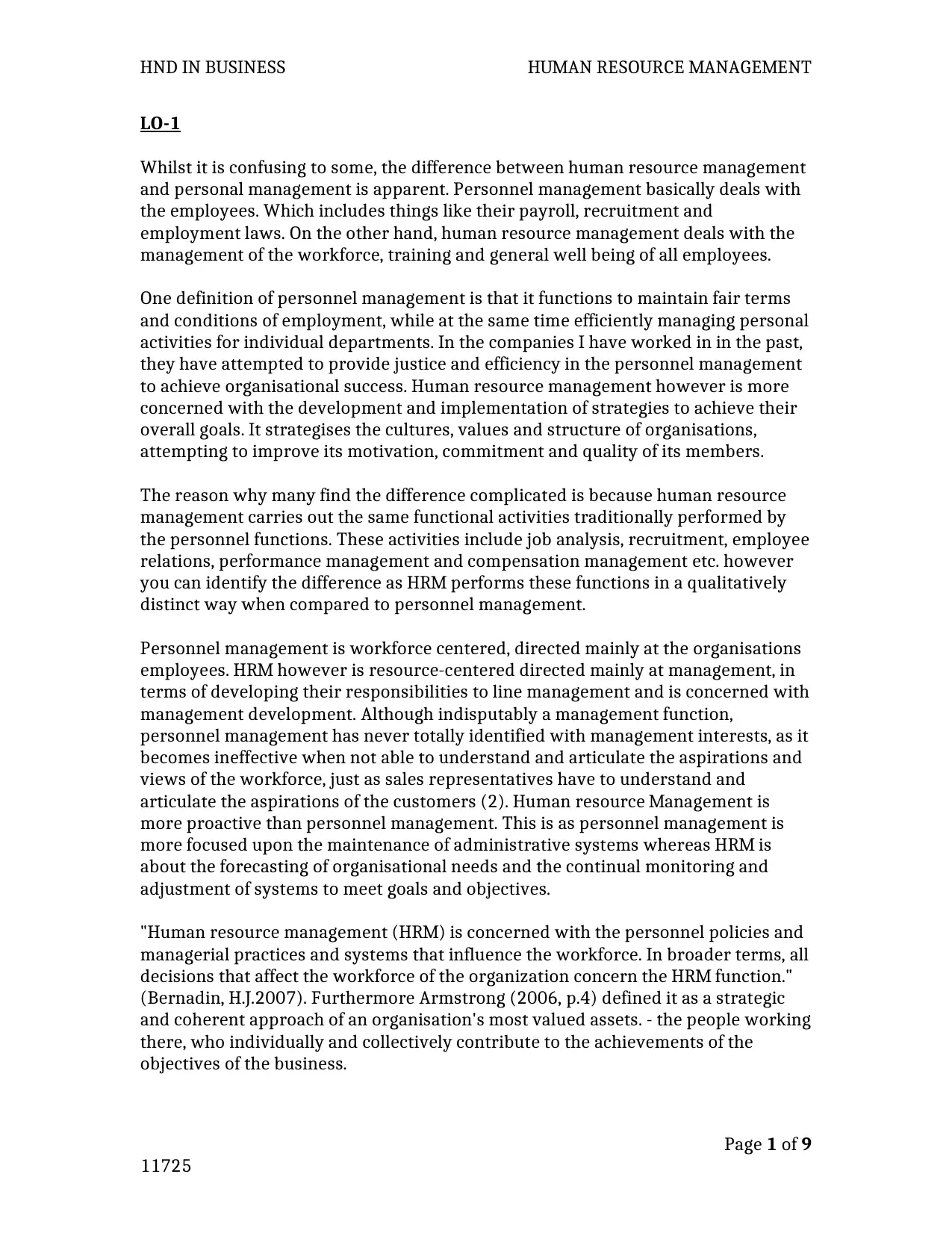
HND IN BUSINESS HUMAN RESOURCE MANAGEMENT
LO-1
Whilst it is confusing to some, the difference between human resource management
and personal management is apparent. Personnel management basically deals with
the employees. Which includes things like their payroll, recruitment and
employment laws. On the other hand, human resource management deals with the
management of the workforce, training and general well being of all employees.
One definition of personnel management is that it functions to maintain fair terms
and conditions of employment, while at the same time efficiently managing personal
activities for individual departments. In the companies I have worked in in the past,
they have attempted to provide justice and efficiency in the personnel management
to achieve organisational success. Human resource management however is more
concerned with the development and implementation of strategies to achieve their
overall goals. It strategises the cultures, values and structure of organisations,
attempting to improve its motivation, commitment and quality of its members.
The reason why many find the difference complicated is because human resource
management carries out the same functional activities traditionally performed by
the personnel functions. These activities include job analysis, recruitment, employee
relations, performance management and compensation management etc. however
you can identify the difference as HRM performs these functions in a qualitatively
distinct way when compared to personnel management.
Personnel management is workforce centered, directed mainly at the organisations
employees. HRM however is resource-centered directed mainly at management, in
terms of developing their responsibilities to line management and is concerned with
management development. Although indisputably a management function,
personnel management has never totally identified with management interests, as it
becomes ineffective when not able to understand and articulate the aspirations and
views of the workforce, just as sales representatives have to understand and
articulate the aspirations of the customers (2). Human resource Management is
more proactive than personnel management. This is as personnel management is
more focused upon the maintenance of administrative systems whereas HRM is
about the forecasting of organisational needs and the continual monitoring and
adjustment of systems to meet goals and objectives.
"Human resource management (HRM) is concerned with the personnel policies and
managerial practices and systems that influence the workforce. In broader terms, all
decisions that affect the workforce of the organization concern the HRM function."
(Bernadin, H.J.2007). Furthermore Armstrong (2006, p.4) defined it as a strategic
and coherent approach of an organisation's most valued assets. - the people working
there, who individually and collectively contribute to the achievements of the
objectives of the business.
Page 1 of 9
11725
LO-1
Whilst it is confusing to some, the difference between human resource management
and personal management is apparent. Personnel management basically deals with
the employees. Which includes things like their payroll, recruitment and
employment laws. On the other hand, human resource management deals with the
management of the workforce, training and general well being of all employees.
One definition of personnel management is that it functions to maintain fair terms
and conditions of employment, while at the same time efficiently managing personal
activities for individual departments. In the companies I have worked in in the past,
they have attempted to provide justice and efficiency in the personnel management
to achieve organisational success. Human resource management however is more
concerned with the development and implementation of strategies to achieve their
overall goals. It strategises the cultures, values and structure of organisations,
attempting to improve its motivation, commitment and quality of its members.
The reason why many find the difference complicated is because human resource
management carries out the same functional activities traditionally performed by
the personnel functions. These activities include job analysis, recruitment, employee
relations, performance management and compensation management etc. however
you can identify the difference as HRM performs these functions in a qualitatively
distinct way when compared to personnel management.
Personnel management is workforce centered, directed mainly at the organisations
employees. HRM however is resource-centered directed mainly at management, in
terms of developing their responsibilities to line management and is concerned with
management development. Although indisputably a management function,
personnel management has never totally identified with management interests, as it
becomes ineffective when not able to understand and articulate the aspirations and
views of the workforce, just as sales representatives have to understand and
articulate the aspirations of the customers (2). Human resource Management is
more proactive than personnel management. This is as personnel management is
more focused upon the maintenance of administrative systems whereas HRM is
about the forecasting of organisational needs and the continual monitoring and
adjustment of systems to meet goals and objectives.
"Human resource management (HRM) is concerned with the personnel policies and
managerial practices and systems that influence the workforce. In broader terms, all
decisions that affect the workforce of the organization concern the HRM function."
(Bernadin, H.J.2007). Furthermore Armstrong (2006, p.4) defined it as a strategic
and coherent approach of an organisation's most valued assets. - the people working
there, who individually and collectively contribute to the achievements of the
objectives of the business.
Page 1 of 9
11725
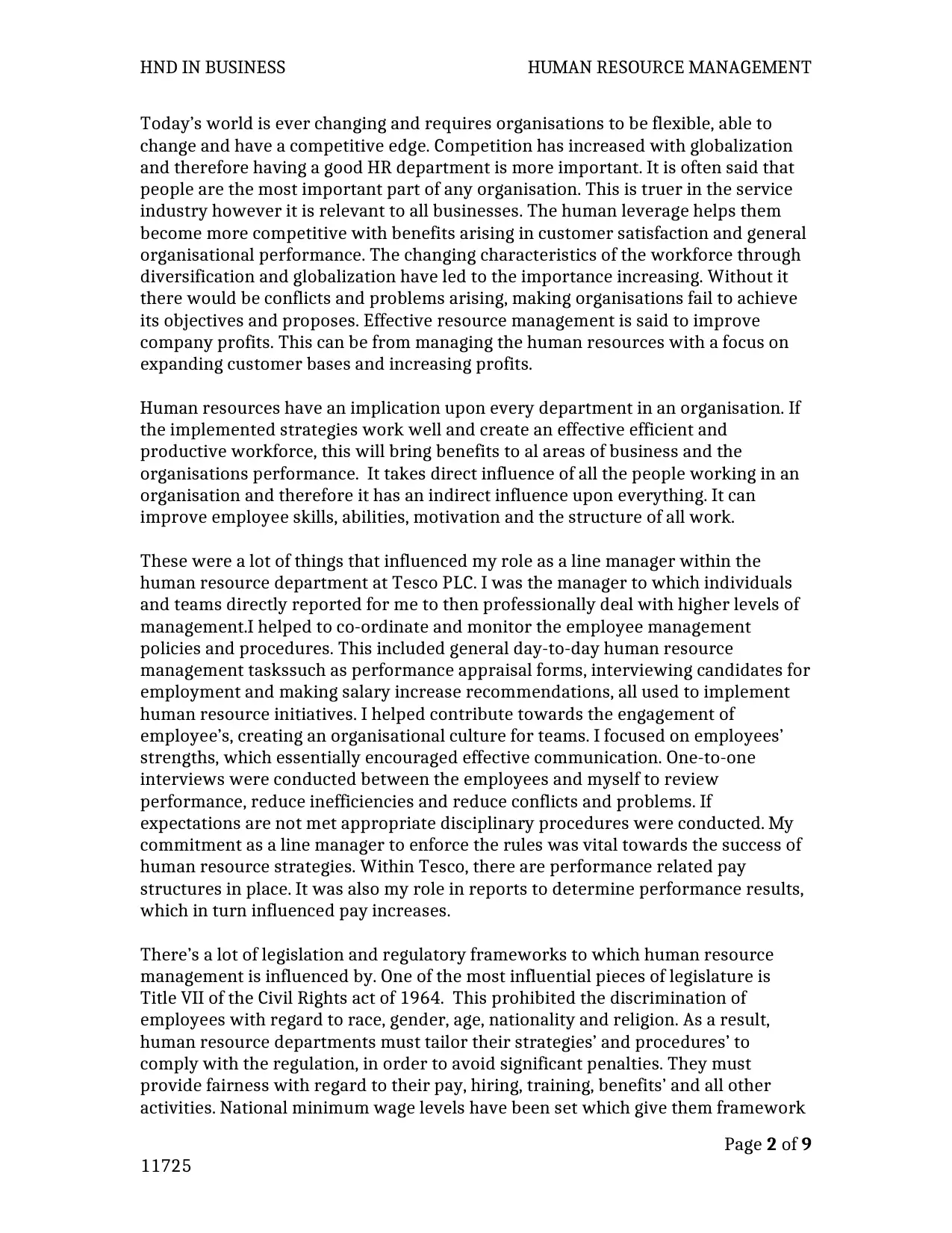
HND IN BUSINESS HUMAN RESOURCE MANAGEMENT
Today’s world is ever changing and requires organisations to be flexible, able to
change and have a competitive edge. Competition has increased with globalization
and therefore having a good HR department is more important. It is often said that
people are the most important part of any organisation. This is truer in the service
industry however it is relevant to all businesses. The human leverage helps them
become more competitive with benefits arising in customer satisfaction and general
organisational performance. The changing characteristics of the workforce through
diversification and globalization have led to the importance increasing. Without it
there would be conflicts and problems arising, making organisations fail to achieve
its objectives and proposes. Effective resource management is said to improve
company profits. This can be from managing the human resources with a focus on
expanding customer bases and increasing profits.
Human resources have an implication upon every department in an organisation. If
the implemented strategies work well and create an effective efficient and
productive workforce, this will bring benefits to al areas of business and the
organisations performance. It takes direct influence of all the people working in an
organisation and therefore it has an indirect influence upon everything. It can
improve employee skills, abilities, motivation and the structure of all work.
These were a lot of things that influenced my role as a line manager within the
human resource department at Tesco PLC. I was the manager to which individuals
and teams directly reported for me to then professionally deal with higher levels of
management.I helped to co-ordinate and monitor the employee management
policies and procedures. This included general day-to-day human resource
management taskssuch as performance appraisal forms, interviewing candidates for
employment and making salary increase recommendations, all used to implement
human resource initiatives. I helped contribute towards the engagement of
employee’s, creating an organisational culture for teams. I focused on employees’
strengths, which essentially encouraged effective communication. One-to-one
interviews were conducted between the employees and myself to review
performance, reduce inefficiencies and reduce conflicts and problems. If
expectations are not met appropriate disciplinary procedures were conducted. My
commitment as a line manager to enforce the rules was vital towards the success of
human resource strategies. Within Tesco, there are performance related pay
structures in place. It was also my role in reports to determine performance results,
which in turn influenced pay increases.
There’s a lot of legislation and regulatory frameworks to which human resource
management is influenced by. One of the most influential pieces of legislature is
Title VII of the Civil Rights act of 1964. This prohibited the discrimination of
employees with regard to race, gender, age, nationality and religion. As a result,
human resource departments must tailor their strategies’ and procedures’ to
comply with the regulation, in order to avoid significant penalties. They must
provide fairness with regard to their pay, hiring, training, benefits’ and all other
activities. National minimum wage levels have been set which give them framework
Page 2 of 9
11725
Today’s world is ever changing and requires organisations to be flexible, able to
change and have a competitive edge. Competition has increased with globalization
and therefore having a good HR department is more important. It is often said that
people are the most important part of any organisation. This is truer in the service
industry however it is relevant to all businesses. The human leverage helps them
become more competitive with benefits arising in customer satisfaction and general
organisational performance. The changing characteristics of the workforce through
diversification and globalization have led to the importance increasing. Without it
there would be conflicts and problems arising, making organisations fail to achieve
its objectives and proposes. Effective resource management is said to improve
company profits. This can be from managing the human resources with a focus on
expanding customer bases and increasing profits.
Human resources have an implication upon every department in an organisation. If
the implemented strategies work well and create an effective efficient and
productive workforce, this will bring benefits to al areas of business and the
organisations performance. It takes direct influence of all the people working in an
organisation and therefore it has an indirect influence upon everything. It can
improve employee skills, abilities, motivation and the structure of all work.
These were a lot of things that influenced my role as a line manager within the
human resource department at Tesco PLC. I was the manager to which individuals
and teams directly reported for me to then professionally deal with higher levels of
management.I helped to co-ordinate and monitor the employee management
policies and procedures. This included general day-to-day human resource
management taskssuch as performance appraisal forms, interviewing candidates for
employment and making salary increase recommendations, all used to implement
human resource initiatives. I helped contribute towards the engagement of
employee’s, creating an organisational culture for teams. I focused on employees’
strengths, which essentially encouraged effective communication. One-to-one
interviews were conducted between the employees and myself to review
performance, reduce inefficiencies and reduce conflicts and problems. If
expectations are not met appropriate disciplinary procedures were conducted. My
commitment as a line manager to enforce the rules was vital towards the success of
human resource strategies. Within Tesco, there are performance related pay
structures in place. It was also my role in reports to determine performance results,
which in turn influenced pay increases.
There’s a lot of legislation and regulatory frameworks to which human resource
management is influenced by. One of the most influential pieces of legislature is
Title VII of the Civil Rights act of 1964. This prohibited the discrimination of
employees with regard to race, gender, age, nationality and religion. As a result,
human resource departments must tailor their strategies’ and procedures’ to
comply with the regulation, in order to avoid significant penalties. They must
provide fairness with regard to their pay, hiring, training, benefits’ and all other
activities. National minimum wage levels have been set which give them framework
Page 2 of 9
11725
⊘ This is a preview!⊘
Do you want full access?
Subscribe today to unlock all pages.

Trusted by 1+ million students worldwide
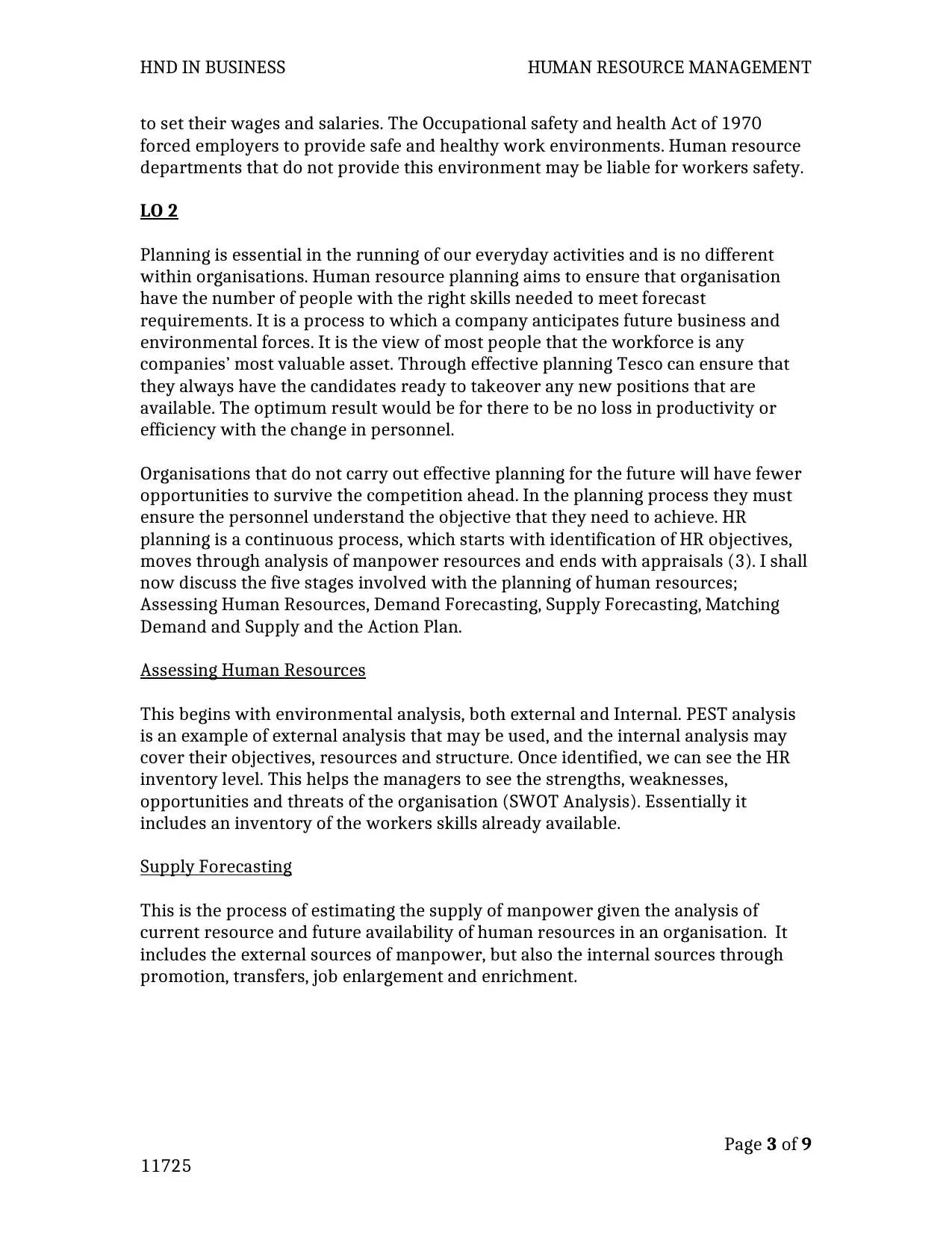
HND IN BUSINESS HUMAN RESOURCE MANAGEMENT
to set their wages and salaries. The Occupational safety and health Act of 1970
forced employers to provide safe and healthy work environments. Human resource
departments that do not provide this environment may be liable for workers safety.
LO 2
Planning is essential in the running of our everyday activities and is no different
within organisations. Human resource planning aims to ensure that organisation
have the number of people with the right skills needed to meet forecast
requirements. It is a process to which a company anticipates future business and
environmental forces. It is the view of most people that the workforce is any
companies’ most valuable asset. Through effective planning Tesco can ensure that
they always have the candidates ready to takeover any new positions that are
available. The optimum result would be for there to be no loss in productivity or
efficiency with the change in personnel.
Organisations that do not carry out effective planning for the future will have fewer
opportunities to survive the competition ahead. In the planning process they must
ensure the personnel understand the objective that they need to achieve. HR
planning is a continuous process, which starts with identification of HR objectives,
moves through analysis of manpower resources and ends with appraisals (3). I shall
now discuss the five stages involved with the planning of human resources;
Assessing Human Resources, Demand Forecasting, Supply Forecasting, Matching
Demand and Supply and the Action Plan.
Assessing Human Resources
This begins with environmental analysis, both external and Internal. PEST analysis
is an example of external analysis that may be used, and the internal analysis may
cover their objectives, resources and structure. Once identified, we can see the HR
inventory level. This helps the managers to see the strengths, weaknesses,
opportunities and threats of the organisation (SWOT Analysis). Essentially it
includes an inventory of the workers skills already available.
Supply Forecasting
This is the process of estimating the supply of manpower given the analysis of
current resource and future availability of human resources in an organisation. It
includes the external sources of manpower, but also the internal sources through
promotion, transfers, job enlargement and enrichment.
Page 3 of 9
11725
to set their wages and salaries. The Occupational safety and health Act of 1970
forced employers to provide safe and healthy work environments. Human resource
departments that do not provide this environment may be liable for workers safety.
LO 2
Planning is essential in the running of our everyday activities and is no different
within organisations. Human resource planning aims to ensure that organisation
have the number of people with the right skills needed to meet forecast
requirements. It is a process to which a company anticipates future business and
environmental forces. It is the view of most people that the workforce is any
companies’ most valuable asset. Through effective planning Tesco can ensure that
they always have the candidates ready to takeover any new positions that are
available. The optimum result would be for there to be no loss in productivity or
efficiency with the change in personnel.
Organisations that do not carry out effective planning for the future will have fewer
opportunities to survive the competition ahead. In the planning process they must
ensure the personnel understand the objective that they need to achieve. HR
planning is a continuous process, which starts with identification of HR objectives,
moves through analysis of manpower resources and ends with appraisals (3). I shall
now discuss the five stages involved with the planning of human resources;
Assessing Human Resources, Demand Forecasting, Supply Forecasting, Matching
Demand and Supply and the Action Plan.
Assessing Human Resources
This begins with environmental analysis, both external and Internal. PEST analysis
is an example of external analysis that may be used, and the internal analysis may
cover their objectives, resources and structure. Once identified, we can see the HR
inventory level. This helps the managers to see the strengths, weaknesses,
opportunities and threats of the organisation (SWOT Analysis). Essentially it
includes an inventory of the workers skills already available.
Supply Forecasting
This is the process of estimating the supply of manpower given the analysis of
current resource and future availability of human resources in an organisation. It
includes the external sources of manpower, but also the internal sources through
promotion, transfers, job enlargement and enrichment.
Page 3 of 9
11725
Paraphrase This Document
Need a fresh take? Get an instant paraphrase of this document with our AI Paraphraser
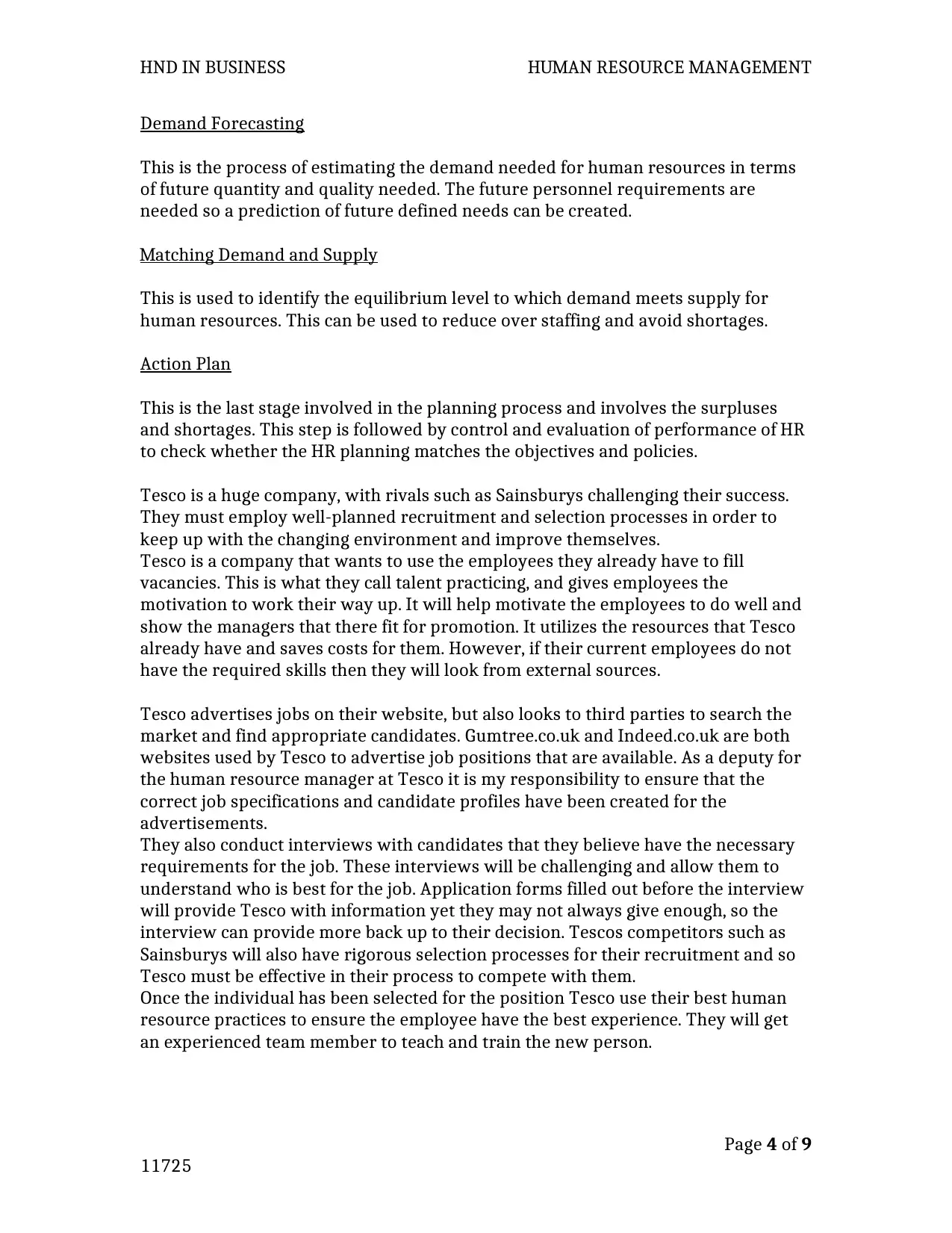
HND IN BUSINESS HUMAN RESOURCE MANAGEMENT
Demand Forecasting
This is the process of estimating the demand needed for human resources in terms
of future quantity and quality needed. The future personnel requirements are
needed so a prediction of future defined needs can be created.
Matching Demand and Supply
This is used to identify the equilibrium level to which demand meets supply for
human resources. This can be used to reduce over staffing and avoid shortages.
Action Plan
This is the last stage involved in the planning process and involves the surpluses
and shortages. This step is followed by control and evaluation of performance of HR
to check whether the HR planning matches the objectives and policies.
Tesco is a huge company, with rivals such as Sainsburys challenging their success.
They must employ well-planned recruitment and selection processes in order to
keep up with the changing environment and improve themselves.
Tesco is a company that wants to use the employees they already have to fill
vacancies. This is what they call talent practicing, and gives employees the
motivation to work their way up. It will help motivate the employees to do well and
show the managers that there fit for promotion. It utilizes the resources that Tesco
already have and saves costs for them. However, if their current employees do not
have the required skills then they will look from external sources.
Tesco advertises jobs on their website, but also looks to third parties to search the
market and find appropriate candidates. Gumtree.co.uk and Indeed.co.uk are both
websites used by Tesco to advertise job positions that are available. As a deputy for
the human resource manager at Tesco it is my responsibility to ensure that the
correct job specifications and candidate profiles have been created for the
advertisements.
They also conduct interviews with candidates that they believe have the necessary
requirements for the job. These interviews will be challenging and allow them to
understand who is best for the job. Application forms filled out before the interview
will provide Tesco with information yet they may not always give enough, so the
interview can provide more back up to their decision. Tescos competitors such as
Sainsburys will also have rigorous selection processes for their recruitment and so
Tesco must be effective in their process to compete with them.
Once the individual has been selected for the position Tesco use their best human
resource practices to ensure the employee have the best experience. They will get
an experienced team member to teach and train the new person.
Page 4 of 9
11725
Demand Forecasting
This is the process of estimating the demand needed for human resources in terms
of future quantity and quality needed. The future personnel requirements are
needed so a prediction of future defined needs can be created.
Matching Demand and Supply
This is used to identify the equilibrium level to which demand meets supply for
human resources. This can be used to reduce over staffing and avoid shortages.
Action Plan
This is the last stage involved in the planning process and involves the surpluses
and shortages. This step is followed by control and evaluation of performance of HR
to check whether the HR planning matches the objectives and policies.
Tesco is a huge company, with rivals such as Sainsburys challenging their success.
They must employ well-planned recruitment and selection processes in order to
keep up with the changing environment and improve themselves.
Tesco is a company that wants to use the employees they already have to fill
vacancies. This is what they call talent practicing, and gives employees the
motivation to work their way up. It will help motivate the employees to do well and
show the managers that there fit for promotion. It utilizes the resources that Tesco
already have and saves costs for them. However, if their current employees do not
have the required skills then they will look from external sources.
Tesco advertises jobs on their website, but also looks to third parties to search the
market and find appropriate candidates. Gumtree.co.uk and Indeed.co.uk are both
websites used by Tesco to advertise job positions that are available. As a deputy for
the human resource manager at Tesco it is my responsibility to ensure that the
correct job specifications and candidate profiles have been created for the
advertisements.
They also conduct interviews with candidates that they believe have the necessary
requirements for the job. These interviews will be challenging and allow them to
understand who is best for the job. Application forms filled out before the interview
will provide Tesco with information yet they may not always give enough, so the
interview can provide more back up to their decision. Tescos competitors such as
Sainsburys will also have rigorous selection processes for their recruitment and so
Tesco must be effective in their process to compete with them.
Once the individual has been selected for the position Tesco use their best human
resource practices to ensure the employee have the best experience. They will get
an experienced team member to teach and train the new person.
Page 4 of 9
11725
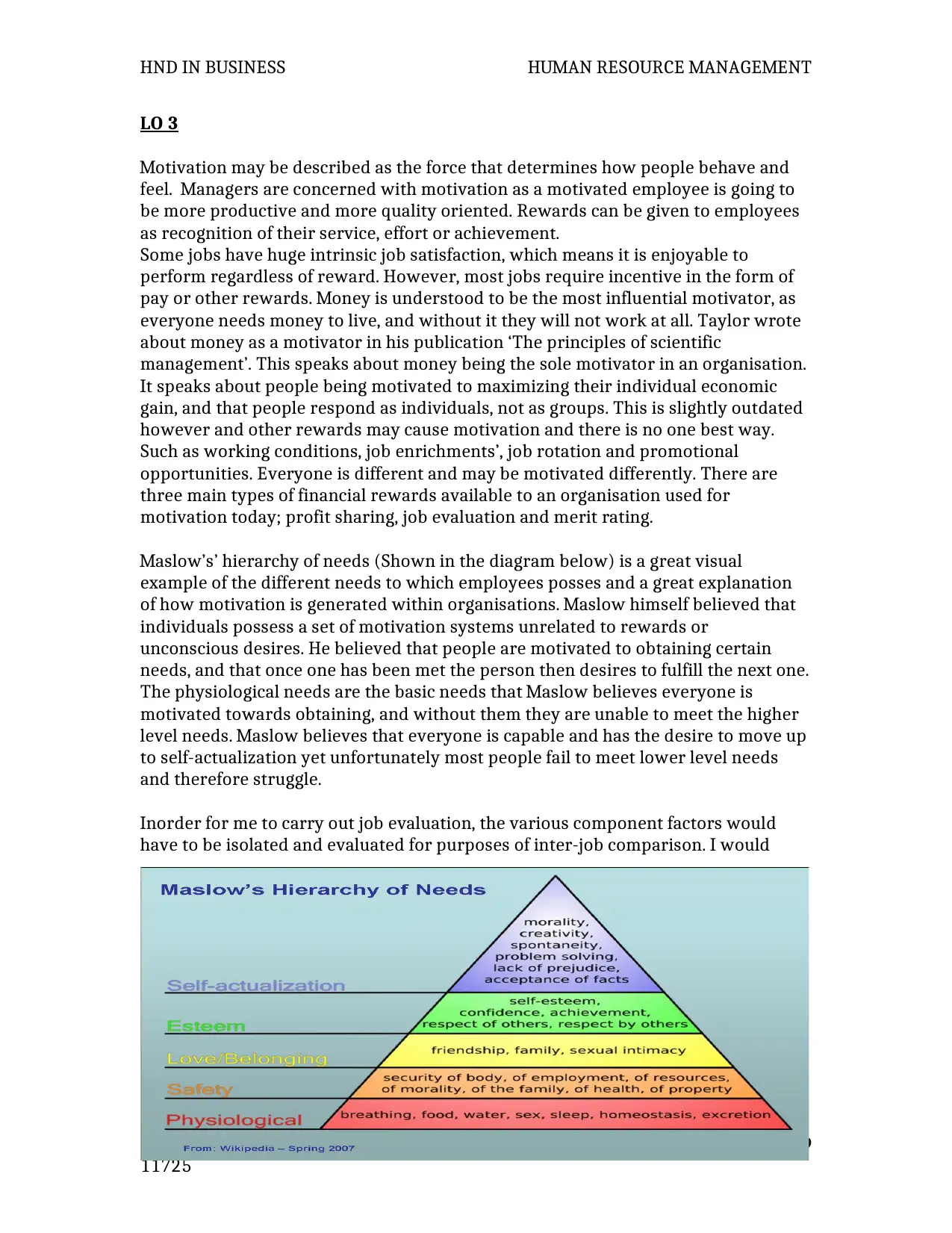
HND IN BUSINESS HUMAN RESOURCE MANAGEMENT
LO 3
Motivation may be described as the force that determines how people behave and
feel. Managers are concerned with motivation as a motivated employee is going to
be more productive and more quality oriented. Rewards can be given to employees
as recognition of their service, effort or achievement.
Some jobs have huge intrinsic job satisfaction, which means it is enjoyable to
perform regardless of reward. However, most jobs require incentive in the form of
pay or other rewards. Money is understood to be the most influential motivator, as
everyone needs money to live, and without it they will not work at all. Taylor wrote
about money as a motivator in his publication ‘The principles of scientific
management’. This speaks about money being the sole motivator in an organisation.
It speaks about people being motivated to maximizing their individual economic
gain, and that people respond as individuals, not as groups. This is slightly outdated
however and other rewards may cause motivation and there is no one best way.
Such as working conditions, job enrichments’, job rotation and promotional
opportunities. Everyone is different and may be motivated differently. There are
three main types of financial rewards available to an organisation used for
motivation today; profit sharing, job evaluation and merit rating.
Maslow’s’ hierarchy of needs (Shown in the diagram below) is a great visual
example of the different needs to which employees posses and a great explanation
of how motivation is generated within organisations. Maslow himself believed that
individuals possess a set of motivation systems unrelated to rewards or
unconscious desires. He believed that people are motivated to obtaining certain
needs, and that once one has been met the person then desires to fulfill the next one.
The physiological needs are the basic needs that Maslow believes everyone is
motivated towards obtaining, and without them they are unable to meet the higher
level needs. Maslow believes that everyone is capable and has the desire to move up
to self-actualization yet unfortunately most people fail to meet lower level needs
and therefore struggle.
Inorder for me to carry out job evaluation, the various component factors would
have to be isolated and evaluated for purposes of inter-job comparison. I would
Page 5 of 9
11725
LO 3
Motivation may be described as the force that determines how people behave and
feel. Managers are concerned with motivation as a motivated employee is going to
be more productive and more quality oriented. Rewards can be given to employees
as recognition of their service, effort or achievement.
Some jobs have huge intrinsic job satisfaction, which means it is enjoyable to
perform regardless of reward. However, most jobs require incentive in the form of
pay or other rewards. Money is understood to be the most influential motivator, as
everyone needs money to live, and without it they will not work at all. Taylor wrote
about money as a motivator in his publication ‘The principles of scientific
management’. This speaks about money being the sole motivator in an organisation.
It speaks about people being motivated to maximizing their individual economic
gain, and that people respond as individuals, not as groups. This is slightly outdated
however and other rewards may cause motivation and there is no one best way.
Such as working conditions, job enrichments’, job rotation and promotional
opportunities. Everyone is different and may be motivated differently. There are
three main types of financial rewards available to an organisation used for
motivation today; profit sharing, job evaluation and merit rating.
Maslow’s’ hierarchy of needs (Shown in the diagram below) is a great visual
example of the different needs to which employees posses and a great explanation
of how motivation is generated within organisations. Maslow himself believed that
individuals possess a set of motivation systems unrelated to rewards or
unconscious desires. He believed that people are motivated to obtaining certain
needs, and that once one has been met the person then desires to fulfill the next one.
The physiological needs are the basic needs that Maslow believes everyone is
motivated towards obtaining, and without them they are unable to meet the higher
level needs. Maslow believes that everyone is capable and has the desire to move up
to self-actualization yet unfortunately most people fail to meet lower level needs
and therefore struggle.
Inorder for me to carry out job evaluation, the various component factors would
have to be isolated and evaluated for purposes of inter-job comparison. I would
Page 5 of 9
11725
⊘ This is a preview!⊘
Do you want full access?
Subscribe today to unlock all pages.

Trusted by 1+ million students worldwide
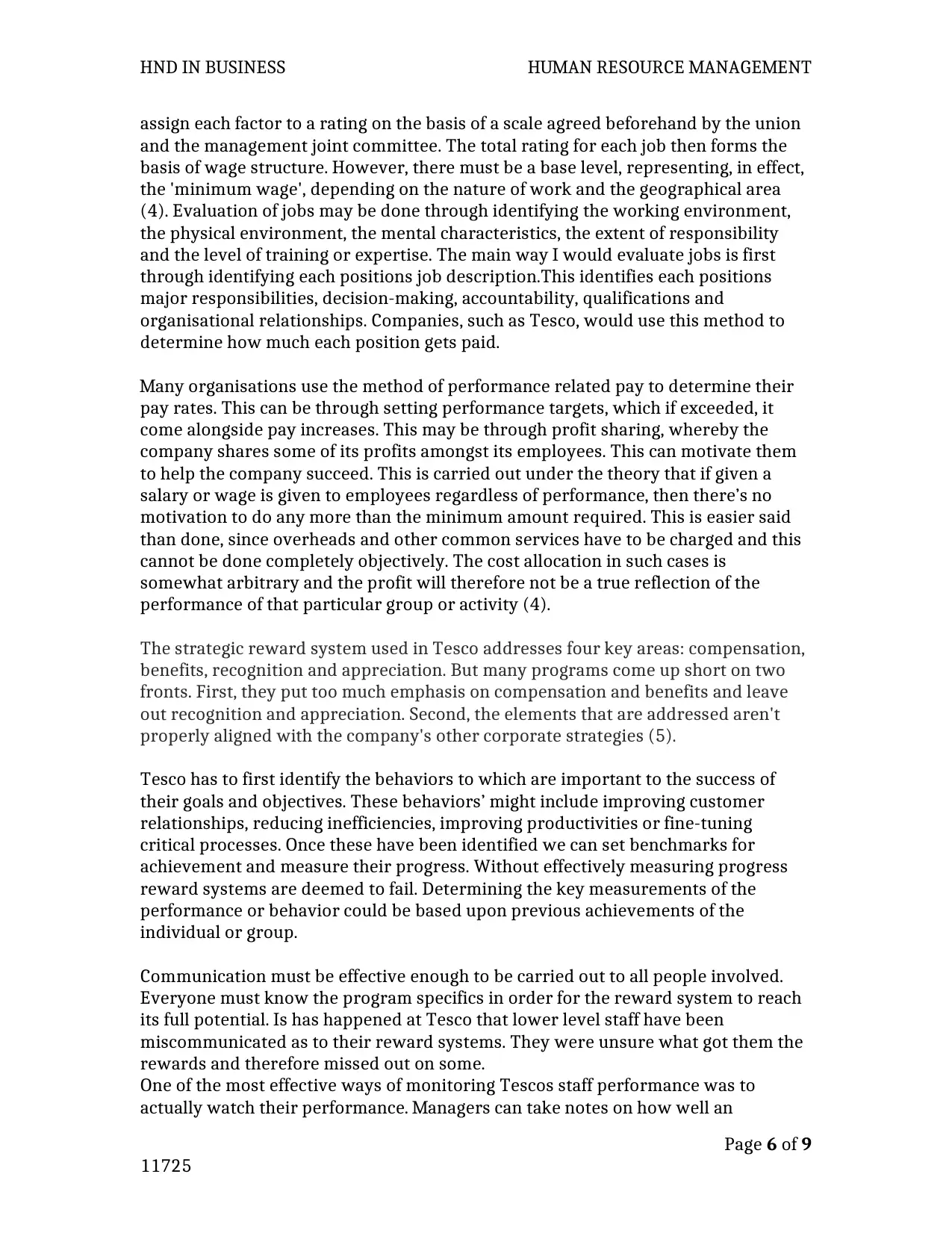
HND IN BUSINESS HUMAN RESOURCE MANAGEMENT
assign each factor to a rating on the basis of a scale agreed beforehand by the union
and the management joint committee. The total rating for each job then forms the
basis of wage structure. However, there must be a base level, representing, in effect,
the 'minimum wage', depending on the nature of work and the geographical area
(4). Evaluation of jobs may be done through identifying the working environment,
the physical environment, the mental characteristics, the extent of responsibility
and the level of training or expertise. The main way I would evaluate jobs is first
through identifying each positions job description.This identifies each positions
major responsibilities, decision-making, accountability, qualifications and
organisational relationships. Companies, such as Tesco, would use this method to
determine how much each position gets paid.
Many organisations use the method of performance related pay to determine their
pay rates. This can be through setting performance targets, which if exceeded, it
come alongside pay increases. This may be through profit sharing, whereby the
company shares some of its profits amongst its employees. This can motivate them
to help the company succeed. This is carried out under the theory that if given a
salary or wage is given to employees regardless of performance, then there’s no
motivation to do any more than the minimum amount required. This is easier said
than done, since overheads and other common services have to be charged and this
cannot be done completely objectively. The cost allocation in such cases is
somewhat arbitrary and the profit will therefore not be a true reflection of the
performance of that particular group or activity (4).
The strategic reward system used in Tesco addresses four key areas: compensation,
benefits, recognition and appreciation. But many programs come up short on two
fronts. First, they put too much emphasis on compensation and benefits and leave
out recognition and appreciation. Second, the elements that are addressed aren't
properly aligned with the company's other corporate strategies (5).
Tesco has to first identify the behaviors to which are important to the success of
their goals and objectives. These behaviors’ might include improving customer
relationships, reducing inefficiencies, improving productivities or fine-tuning
critical processes. Once these have been identified we can set benchmarks for
achievement and measure their progress. Without effectively measuring progress
reward systems are deemed to fail. Determining the key measurements of the
performance or behavior could be based upon previous achievements of the
individual or group.
Communication must be effective enough to be carried out to all people involved.
Everyone must know the program specifics in order for the reward system to reach
its full potential. Is has happened at Tesco that lower level staff have been
miscommunicated as to their reward systems. They were unsure what got them the
rewards and therefore missed out on some.
One of the most effective ways of monitoring Tescos staff performance was to
actually watch their performance. Managers can take notes on how well an
Page 6 of 9
11725
assign each factor to a rating on the basis of a scale agreed beforehand by the union
and the management joint committee. The total rating for each job then forms the
basis of wage structure. However, there must be a base level, representing, in effect,
the 'minimum wage', depending on the nature of work and the geographical area
(4). Evaluation of jobs may be done through identifying the working environment,
the physical environment, the mental characteristics, the extent of responsibility
and the level of training or expertise. The main way I would evaluate jobs is first
through identifying each positions job description.This identifies each positions
major responsibilities, decision-making, accountability, qualifications and
organisational relationships. Companies, such as Tesco, would use this method to
determine how much each position gets paid.
Many organisations use the method of performance related pay to determine their
pay rates. This can be through setting performance targets, which if exceeded, it
come alongside pay increases. This may be through profit sharing, whereby the
company shares some of its profits amongst its employees. This can motivate them
to help the company succeed. This is carried out under the theory that if given a
salary or wage is given to employees regardless of performance, then there’s no
motivation to do any more than the minimum amount required. This is easier said
than done, since overheads and other common services have to be charged and this
cannot be done completely objectively. The cost allocation in such cases is
somewhat arbitrary and the profit will therefore not be a true reflection of the
performance of that particular group or activity (4).
The strategic reward system used in Tesco addresses four key areas: compensation,
benefits, recognition and appreciation. But many programs come up short on two
fronts. First, they put too much emphasis on compensation and benefits and leave
out recognition and appreciation. Second, the elements that are addressed aren't
properly aligned with the company's other corporate strategies (5).
Tesco has to first identify the behaviors to which are important to the success of
their goals and objectives. These behaviors’ might include improving customer
relationships, reducing inefficiencies, improving productivities or fine-tuning
critical processes. Once these have been identified we can set benchmarks for
achievement and measure their progress. Without effectively measuring progress
reward systems are deemed to fail. Determining the key measurements of the
performance or behavior could be based upon previous achievements of the
individual or group.
Communication must be effective enough to be carried out to all people involved.
Everyone must know the program specifics in order for the reward system to reach
its full potential. Is has happened at Tesco that lower level staff have been
miscommunicated as to their reward systems. They were unsure what got them the
rewards and therefore missed out on some.
One of the most effective ways of monitoring Tescos staff performance was to
actually watch their performance. Managers can take notes on how well an
Page 6 of 9
11725
Paraphrase This Document
Need a fresh take? Get an instant paraphrase of this document with our AI Paraphraser
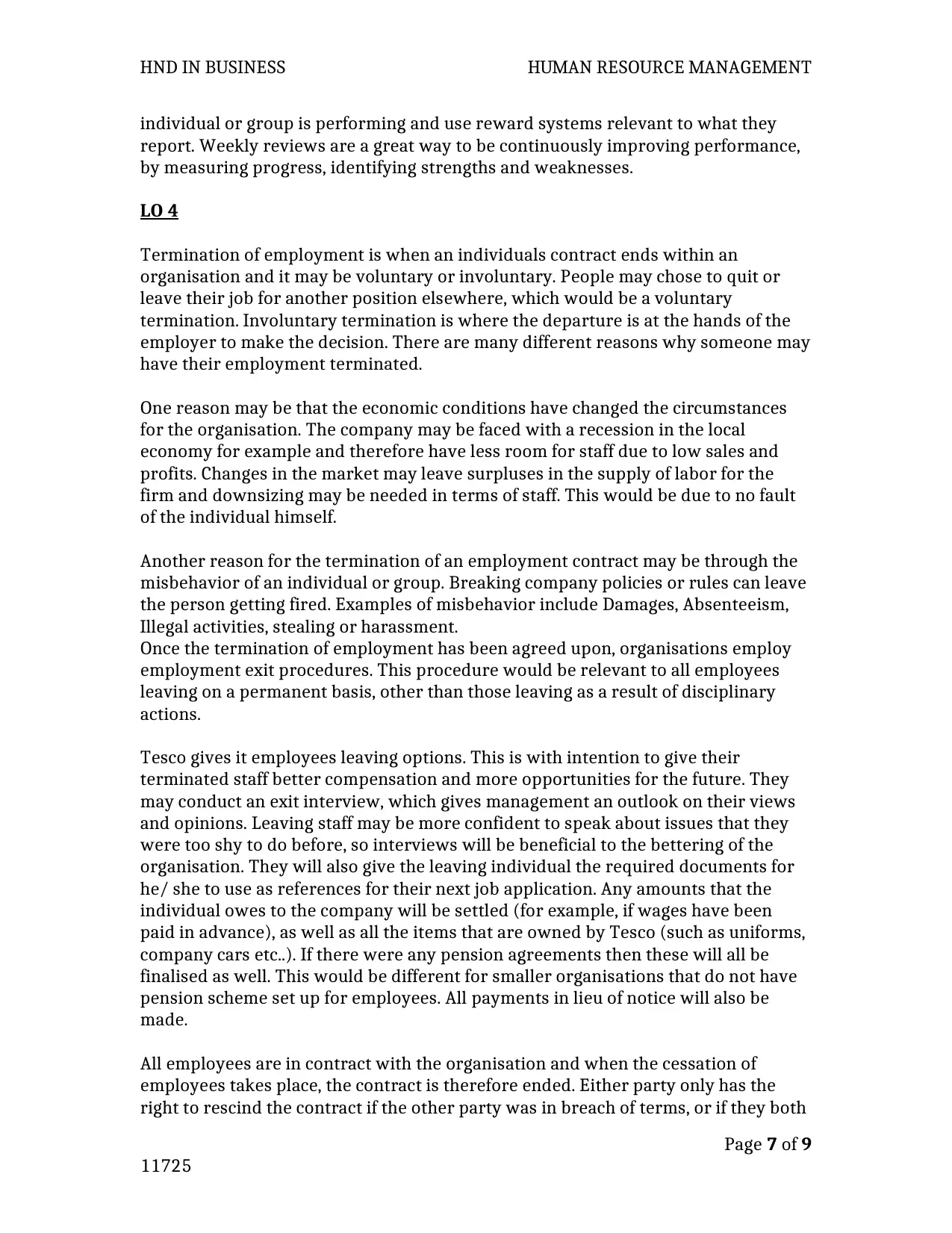
HND IN BUSINESS HUMAN RESOURCE MANAGEMENT
individual or group is performing and use reward systems relevant to what they
report. Weekly reviews are a great way to be continuously improving performance,
by measuring progress, identifying strengths and weaknesses.
LO 4
Termination of employment is when an individuals contract ends within an
organisation and it may be voluntary or involuntary. People may chose to quit or
leave their job for another position elsewhere, which would be a voluntary
termination. Involuntary termination is where the departure is at the hands of the
employer to make the decision. There are many different reasons why someone may
have their employment terminated.
One reason may be that the economic conditions have changed the circumstances
for the organisation. The company may be faced with a recession in the local
economy for example and therefore have less room for staff due to low sales and
profits. Changes in the market may leave surpluses in the supply of labor for the
firm and downsizing may be needed in terms of staff. This would be due to no fault
of the individual himself.
Another reason for the termination of an employment contract may be through the
misbehavior of an individual or group. Breaking company policies or rules can leave
the person getting fired. Examples of misbehavior include Damages, Absenteeism,
Illegal activities, stealing or harassment.
Once the termination of employment has been agreed upon, organisations employ
employment exit procedures. This procedure would be relevant to all employees
leaving on a permanent basis, other than those leaving as a result of disciplinary
actions.
Tesco gives it employees leaving options. This is with intention to give their
terminated staff better compensation and more opportunities for the future. They
may conduct an exit interview, which gives management an outlook on their views
and opinions. Leaving staff may be more confident to speak about issues that they
were too shy to do before, so interviews will be beneficial to the bettering of the
organisation. They will also give the leaving individual the required documents for
he/ she to use as references for their next job application. Any amounts that the
individual owes to the company will be settled (for example, if wages have been
paid in advance), as well as all the items that are owned by Tesco (such as uniforms,
company cars etc..). If there were any pension agreements then these will all be
finalised as well. This would be different for smaller organisations that do not have
pension scheme set up for employees. All payments in lieu of notice will also be
made.
All employees are in contract with the organisation and when the cessation of
employees takes place, the contract is therefore ended. Either party only has the
right to rescind the contract if the other party was in breach of terms, or if they both
Page 7 of 9
11725
individual or group is performing and use reward systems relevant to what they
report. Weekly reviews are a great way to be continuously improving performance,
by measuring progress, identifying strengths and weaknesses.
LO 4
Termination of employment is when an individuals contract ends within an
organisation and it may be voluntary or involuntary. People may chose to quit or
leave their job for another position elsewhere, which would be a voluntary
termination. Involuntary termination is where the departure is at the hands of the
employer to make the decision. There are many different reasons why someone may
have their employment terminated.
One reason may be that the economic conditions have changed the circumstances
for the organisation. The company may be faced with a recession in the local
economy for example and therefore have less room for staff due to low sales and
profits. Changes in the market may leave surpluses in the supply of labor for the
firm and downsizing may be needed in terms of staff. This would be due to no fault
of the individual himself.
Another reason for the termination of an employment contract may be through the
misbehavior of an individual or group. Breaking company policies or rules can leave
the person getting fired. Examples of misbehavior include Damages, Absenteeism,
Illegal activities, stealing or harassment.
Once the termination of employment has been agreed upon, organisations employ
employment exit procedures. This procedure would be relevant to all employees
leaving on a permanent basis, other than those leaving as a result of disciplinary
actions.
Tesco gives it employees leaving options. This is with intention to give their
terminated staff better compensation and more opportunities for the future. They
may conduct an exit interview, which gives management an outlook on their views
and opinions. Leaving staff may be more confident to speak about issues that they
were too shy to do before, so interviews will be beneficial to the bettering of the
organisation. They will also give the leaving individual the required documents for
he/ she to use as references for their next job application. Any amounts that the
individual owes to the company will be settled (for example, if wages have been
paid in advance), as well as all the items that are owned by Tesco (such as uniforms,
company cars etc..). If there were any pension agreements then these will all be
finalised as well. This would be different for smaller organisations that do not have
pension scheme set up for employees. All payments in lieu of notice will also be
made.
All employees are in contract with the organisation and when the cessation of
employees takes place, the contract is therefore ended. Either party only has the
right to rescind the contract if the other party was in breach of terms, or if they both
Page 7 of 9
11725
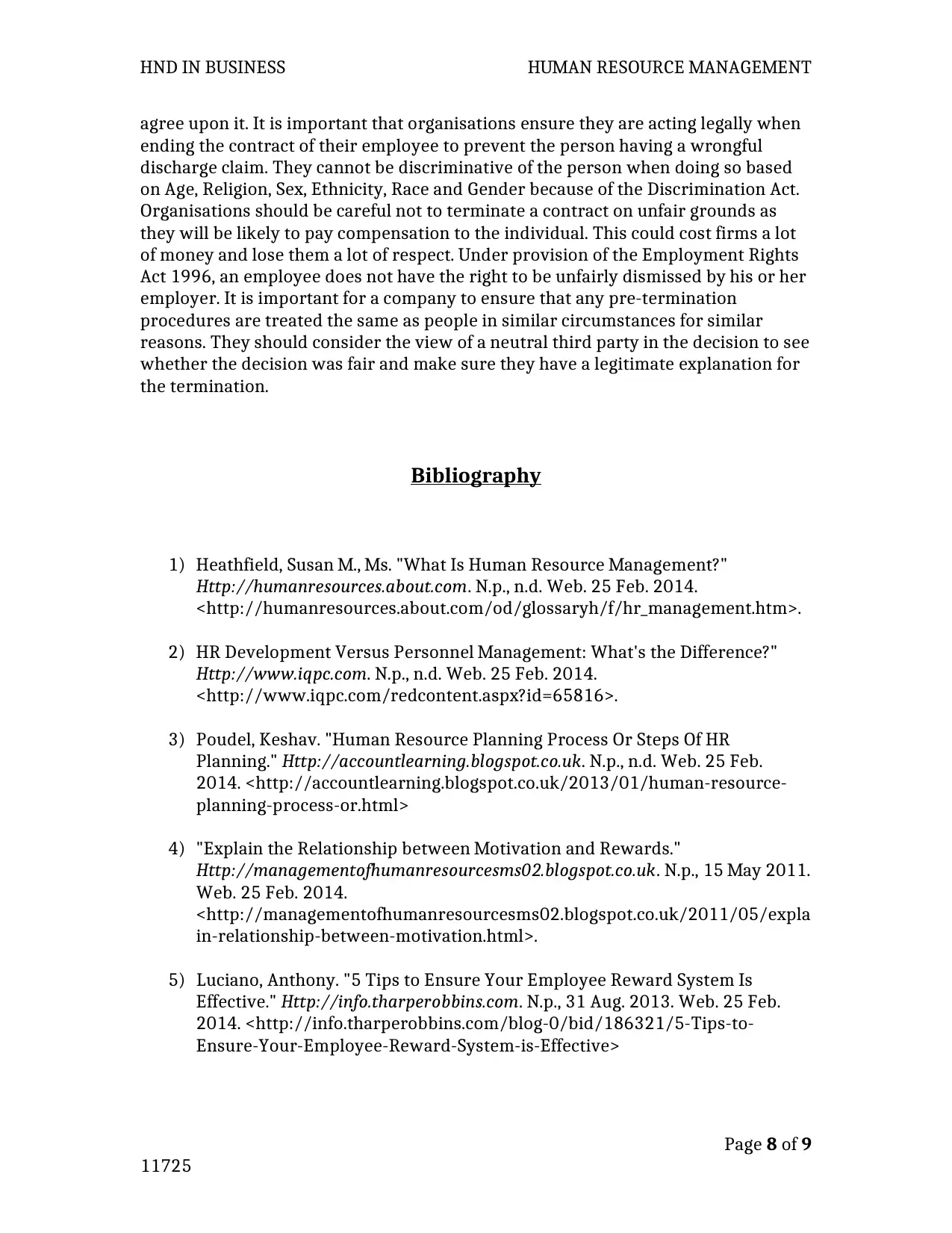
HND IN BUSINESS HUMAN RESOURCE MANAGEMENT
agree upon it. It is important that organisations ensure they are acting legally when
ending the contract of their employee to prevent the person having a wrongful
discharge claim. They cannot be discriminative of the person when doing so based
on Age, Religion, Sex, Ethnicity, Race and Gender because of the Discrimination Act.
Organisations should be careful not to terminate a contract on unfair grounds as
they will be likely to pay compensation to the individual. This could cost firms a lot
of money and lose them a lot of respect. Under provision of the Employment Rights
Act 1996, an employee does not have the right to be unfairly dismissed by his or her
employer. It is important for a company to ensure that any pre-termination
procedures are treated the same as people in similar circumstances for similar
reasons. They should consider the view of a neutral third party in the decision to see
whether the decision was fair and make sure they have a legitimate explanation for
the termination.
Bibliography
1) Heathfield, Susan M., Ms. "What Is Human Resource Management?"
Http://humanresources.about.com. N.p., n.d. Web. 25 Feb. 2014.
<http://humanresources.about.com/od/glossaryh/f/hr_management.htm>.
2) HR Development Versus Personnel Management: What's the Difference?"
Http://www.iqpc.com. N.p., n.d. Web. 25 Feb. 2014.
<http://www.iqpc.com/redcontent.aspx?id=65816>.
3) Poudel, Keshav. "Human Resource Planning Process Or Steps Of HR
Planning." Http://accountlearning.blogspot.co.uk. N.p., n.d. Web. 25 Feb.
2014. <http://accountlearning.blogspot.co.uk/2013/01/human-resource-
planning-process-or.html>
4) "Explain the Relationship between Motivation and Rewards."
Http://managementofhumanresourcesms02.blogspot.co.uk. N.p., 15 May 2011.
Web. 25 Feb. 2014.
<http://managementofhumanresourcesms02.blogspot.co.uk/2011/05/expla
in-relationship-between-motivation.html>.
5) Luciano, Anthony. "5 Tips to Ensure Your Employee Reward System Is
Effective." Http://info.tharperobbins.com. N.p., 31 Aug. 2013. Web. 25 Feb.
2014. <http://info.tharperobbins.com/blog-0/bid/186321/5-Tips-to-
Ensure-Your-Employee-Reward-System-is-Effective>
Page 8 of 9
11725
agree upon it. It is important that organisations ensure they are acting legally when
ending the contract of their employee to prevent the person having a wrongful
discharge claim. They cannot be discriminative of the person when doing so based
on Age, Religion, Sex, Ethnicity, Race and Gender because of the Discrimination Act.
Organisations should be careful not to terminate a contract on unfair grounds as
they will be likely to pay compensation to the individual. This could cost firms a lot
of money and lose them a lot of respect. Under provision of the Employment Rights
Act 1996, an employee does not have the right to be unfairly dismissed by his or her
employer. It is important for a company to ensure that any pre-termination
procedures are treated the same as people in similar circumstances for similar
reasons. They should consider the view of a neutral third party in the decision to see
whether the decision was fair and make sure they have a legitimate explanation for
the termination.
Bibliography
1) Heathfield, Susan M., Ms. "What Is Human Resource Management?"
Http://humanresources.about.com. N.p., n.d. Web. 25 Feb. 2014.
<http://humanresources.about.com/od/glossaryh/f/hr_management.htm>.
2) HR Development Versus Personnel Management: What's the Difference?"
Http://www.iqpc.com. N.p., n.d. Web. 25 Feb. 2014.
<http://www.iqpc.com/redcontent.aspx?id=65816>.
3) Poudel, Keshav. "Human Resource Planning Process Or Steps Of HR
Planning." Http://accountlearning.blogspot.co.uk. N.p., n.d. Web. 25 Feb.
2014. <http://accountlearning.blogspot.co.uk/2013/01/human-resource-
planning-process-or.html>
4) "Explain the Relationship between Motivation and Rewards."
Http://managementofhumanresourcesms02.blogspot.co.uk. N.p., 15 May 2011.
Web. 25 Feb. 2014.
<http://managementofhumanresourcesms02.blogspot.co.uk/2011/05/expla
in-relationship-between-motivation.html>.
5) Luciano, Anthony. "5 Tips to Ensure Your Employee Reward System Is
Effective." Http://info.tharperobbins.com. N.p., 31 Aug. 2013. Web. 25 Feb.
2014. <http://info.tharperobbins.com/blog-0/bid/186321/5-Tips-to-
Ensure-Your-Employee-Reward-System-is-Effective>
Page 8 of 9
11725
⊘ This is a preview!⊘
Do you want full access?
Subscribe today to unlock all pages.

Trusted by 1+ million students worldwide
1 out of 9
Related Documents
Your All-in-One AI-Powered Toolkit for Academic Success.
+13062052269
info@desklib.com
Available 24*7 on WhatsApp / Email
![[object Object]](/_next/static/media/star-bottom.7253800d.svg)
Unlock your academic potential
Copyright © 2020–2025 A2Z Services. All Rights Reserved. Developed and managed by ZUCOL.




